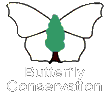
| Butterfly Conservation |
|
| saving butterflies, moths and their habitats |
 |
|
|||
|
| ||||
| Sussex Branch | ||||
|
| ||||
|
|
Thurs 30 Mar The weather may be milder now but still no flush of butterflies to report, so a good chance to put up the website's first Sussex picture to show how they will look, and give a taste of what's to come later in the year. The image is a 360x240 pixels jpeg at quality 5.
Silver-spotted Skipper, Belle Tout, Beachy Head (13 Aug 05, Jim Steedman)
Weds 29 March 1 Red Admiral, 1 Brimstone male, West Dean Woods SU 842 154 (Margaret Hibbard)
Red Admiral in the Pannel Valley (per www.rxwildlife.org.uk)
Tues 28 March Dru Brook reports one Painted Lady and one Red Admiral in McIntyres Field just above the allotments, Lancing Ring LNR (per Ray Hamblett)
Sat 25 Mar No moths came to an all-night Skinner trap in Peacehaven garden with 15w actinic light despite mild cloudy conditions (Adrian Thomas)
Thurs 24 Mar Male Brimstone in Brede High Wood, Powdermill Reservoir, TQ798206 (Dan Hoare)
Thurs 23 Mar Red Admiral seen in Seaford garden despite strong wind (Roy Neeve) Small Tortoiseshell seen in our East Dean garden then nectaring on neighbour's Erica. It was sunny but with a very strong wind (our first garden ST last year was on 16 March). (David Jode)
Sun 19 Mar Andy Brook reported a Brimstone in Ring Road, North Lancing earlier today (per Ray Hamblett)
Small number of Red Admiral and Small Tortoiseshell reported from Friston Forest (per David Jode)
Sat 18 Mar Comma in Saltdean garden (David West)
Weds 15 March Peacock reported from near Lewes prison (per www.sos.org.uk/news)
Mon 6 March The first Peacock butterfly of the year has been reported by Dru Brook, it was seen near the car park, Lancing Ring. The temperature has improved today and almost managed 10ºC on the garden thermometer (per Ray Hamblett)
Sun 5 March Small Tortoiseshell reported from Lewes (per www.sos.org.uk/news)
What to look for in March
The website at this stage had yet to be advertised to Butterfly Conservation members (or indeed anywhere except by word of mouth!) which may explain the lack of butterfly and moth records for February. However, the protracted cold weather has given very little opportunity for any to fly.
What to look for in February:
Tues 24 Jan 2006 Two Red Admirals near Alfriston (per www.sos.org.uk/news)
Sat 21 Jan 2006 Red Admiral at Burton Mill Pond (per www.sos.org.uk/news) Red Admiral at Southwick (per www.sos.org.uk/news)
Tues 3 Jan 2006
Red Admiral in the Pannel Valley near Icklesham (per
www.rxwildlife.org.uk) |
||||||||||||||||||||||||||||||||||||||||||||||||||||||
|
|
|
|
| Copyright Butterfly Conservation © 2006 Sussex Branch |
|
|
| Privacy and Copyright Statement |
|
|
| Butterfly Conservation is a registered charity and non-profit-making company, limited by guarantee. Registered in England No.2206468. Registered Charity No.254937. |
|
|
|
|